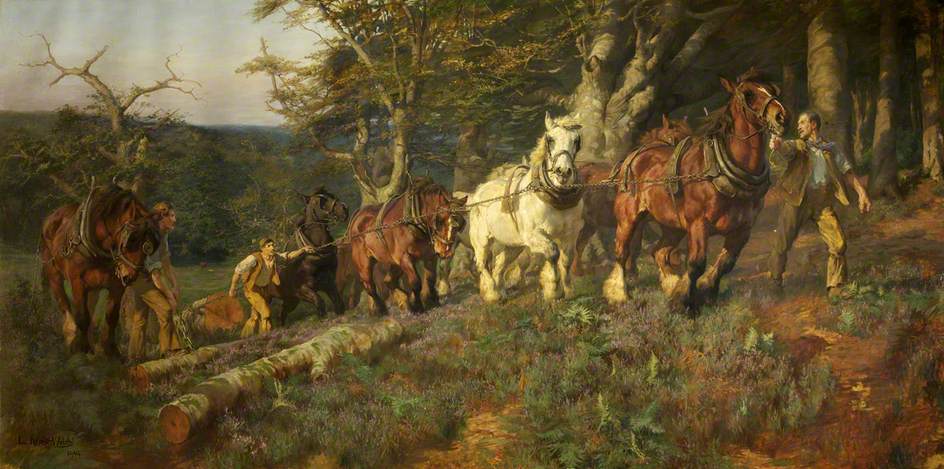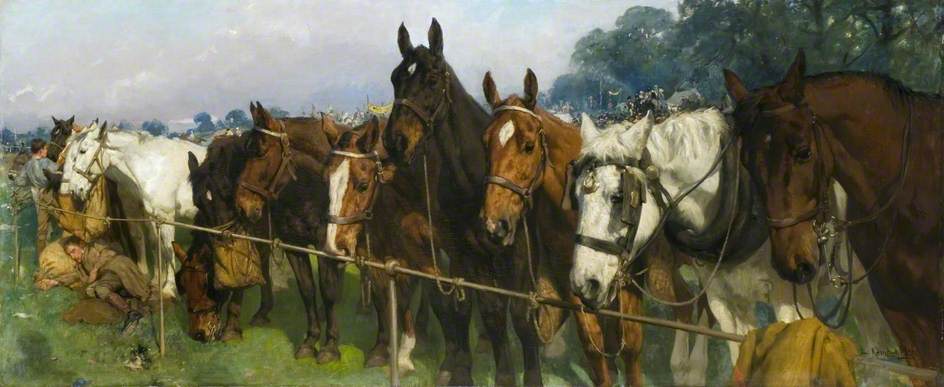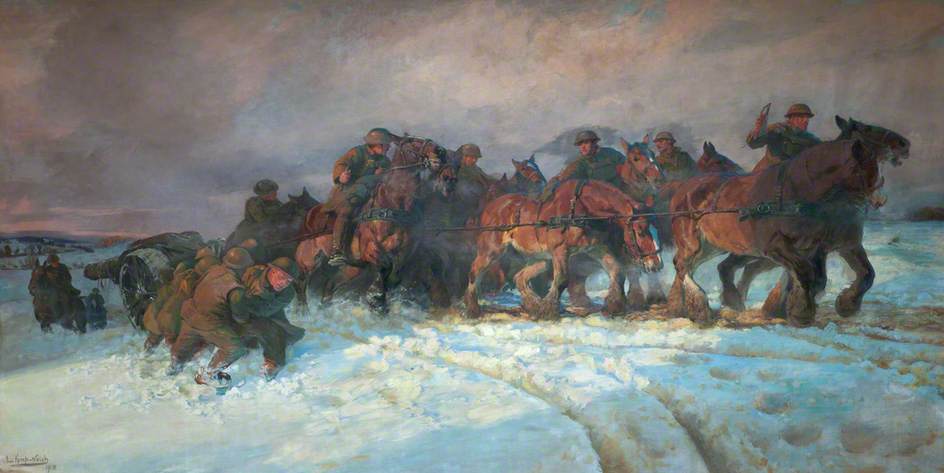Kemp-Welch sent the first of sixty-one paintings, Gipsy Horse Drovers, to the Royal Academy in 1895. Just two years later Colt Hunting in the New Forest was critically acclaimed, purchased by the RA and given to the newly formed Tate collection. Kemp-Welch's signature style was established: large scale, working horses depicted in motion in a landscape setting with a loose naturalism. She did attempt to branch out. The late 1890s saw some unsuccessful history paintings (To Arms, Early Morning in the Camp of the Duke of York's Army before the Battle of the Roses at St Albans, 1898) and she experimented with imagined Boer War subjects. Later she would also produce The Riders (1910) based on a Robert Browning poem, a work which sits more comfortably with her illustrations for Black Beauty (1915) than with her large scale oils. She was primarily an observer who sketched from life obsessively and had a glass studio constructed to observe horses outside in all weathers. Arguably her greatest skill was to create characterful and individualised horses - rather like a less sentimental Landseer - so, for instance, Mixed Company at a Race Meeting (1904) becomes almost like an equine version of Thompson's Roll Call in which the everyday is elevated to status of hero.
In many ways, Kemp-Welch's life was as restrictive as her subject matter often appears. She never married and continued to live at Bushey with her sister until Edith died in 1941. She went abroad only twice and was content to make sketching tours within the UK each summer. Her career undoubtedly suffered because of her sex. Like Thompson, she failed in her attempt to become the first female Academician since the eighteenth century. However, she made the most of what was available to her. Wherever she travelled, she sketched and recorded what she saw, and many of the locations ended up in her finished oils. She was a founder member and first president of the short lived Society of Animal Painters, a clear attempt to elevate the status of her genre. She was one of the first women members of the Society of British Artists, and had a long and financially successful career.
She suffered discrimination most cruelly during the First World War. Despite her popular and influential recruiting poster Forward! Forward to Victory Enlist Now (1914) as a woman she was not allowed to travel to France as a war artist. She had to content herself with observing manoeuvres on Salisbury Plain and at Russley Park Remount Depot (for retraining horses). Ironically, she produced two of her most iconic works Forward the Guns (1917) and Straw Ride (1919) during this period but it must have rankled that Alfred Munnings, a younger, lesser-known horse painter was commissioned by the Canadian government to paint on the Western Front and effectively launched a career which took him all the way to President of the RA, from his war paintings.
Kemp-Welch took over Herkomer's school when he retired in 1906, but with limited success. The school declined from 1914 and closed completely in the 1920s. Its failure perhaps reflected a general decline in Kemp-Welch's reputation and production. The horse was part of the past, increasingly relegated to circuses (which she painted regularly throughout the inter-wars years) and elite leisure (which she had always been less interested in), and by the time she exhibited her last major work The Call in 1937, she had to fake the horse-drawn lifeboat shown because it had been discontinued.
Perhaps Lucy Kemp-Welch was born a generation too late. Her work has much in common with that of the Newlyn School, doing for the working horse what they did for fishing communities. The Harvesters (1898) has the romanticised rural realism and rich palette of George Clausen's scenes of agricultural workers. She was one of those hard to categorise 'British Impressionists' who applied a loosened technique and plein air observation, but preferred to work up their subjects indoors, on a larger scale. It was a style which became rapidly obsolete in the early years of the twentieth century, and by the time of her death Kemp-Welch was a forgotten and unappreciated figure. A revival of interest in British Impressionism in the early 1990s seemed to largely ignore her, perhaps, dare I say because she was a woman, certainly because she had little contact with the established art colonies and exhibited at the Academy. Neither Tate Britain nor the Imperial War Museum currently have their examples on display. Hopefully a 2023 book and exhibition (at Russell-Cotes Museum in Bournemouth) will kickstart interest in her work.





No comments:
Post a Comment